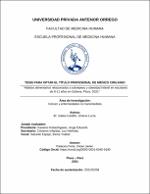Hábitos alimentarios relacionados a sobrepeso y obesidad infantil en escolares de 8-11 años en Sullana, Piura, 2020

Ver/
Descargar
(application/pdf: 791.9Kb)
(application/pdf: 791.9Kb)
Fecha
2021Autor(es)
Galea Castillo, Jimena Lucia
Metadatos
Mostrar el registro completo del ítemResumen
Objetivo general: Determinar si existe relación entre los hábitos alimentarios con
el sobrepeso y la obesidad infantil en escolares de 8 a 11 años del Colegio “Santa
Úrsula” en la provincia de Sullana, Piura durante el año 2020. Material y método:
Realizamos un estudio transversal a escolares con la aplicación de cuestionarios
virtuales para conocer sus hábitos alimentarios y obtener datos antropométricos
que nos permitieron conocer el Índice de Masa Corporal (IMC). Toda la
información fue analizada en pruebas como ANOVA, Post hoc Tukey b y
Regresión logística binaria. Resultados: De una población conformada por 211
escolares de 8 a 11 años de edad del colegio “Santa Úrsula”, encuestamos a 83
escolares de sexo masculino y 128 escolares de sexo femenino. Tuvimos como
resultado que un 83,9% de escolares tienen hábitos saludables, mientras que un
16,1% tienen hábitos no saludables. Ellos representan un 35,5% como normal;
40,8% con sobrepeso y 23,7% con obesidad con respecto a los estados de
clasificación del IMC. Según análisis bivariado no existe relación directa entre los
hábitos alimentarios no saludables con el sobrepeso y la obesidad infantil. En el
análisis multivariado no se encontró que las variables edad y hábitos saludables
se asocien a la variable de interés. Conclusión: El sobrepeso ni la obesidad
guardan relación con los hábitos alimentarios del escolar. La prevalencia de
Sobrepeso y obesidad en escolares de 8 a 11 años del Colegio “Santa Úrsula” fue
alta; 4 de 6 escolares tienen sobrepeso y 2 de 10 obesidad. La prevalencia de
hábitos saludables fue más del 80% de la población escolar de 8 a 11 años,
mientras que ni el 20% tuvieron hábitos No saludables. General objective: To determine if there is a relationship between eating habits
with overweight and childhood obesity in schoolchildren aged 8 to 11 years of the
Colegio “Santa Úrsula“ in the province of Sullana, Piura during 2020. Material and
method: We conducted a study transversal to schoolchildren with the application
of virtual questionnaires to know their eating habits and obtain anthropometric data
that allowed us to know the Body Mass Index (BMI). All the information was
analyzed in tests such as ANOVA, Post hoc Tukey b and binary logistic regression.
Results: From a population made up of 211 schoolchildren between the ages of 8
and 11 from the “Santa Úrsula” school, we surveyed 83 male students and 128
female students. We had as a result that 83.9% of schoolchildren have healthy
habits, while 16.1% have unhealthy habits. They represent 35.5% as normal;
40.8% overweight and 23.7% obese with respect to the BMI classification states.
According to bivariate analysis, there is no direct relationship between unhealthy
eating habits with overweight and childhood obesity. In the multivariate analysis, it
was not found that the variables age and healthy habits are associated with the
variable of interest. Conclusion: Neither overweight nor obesity is related to the
school's eating habits. The prevalence of overweight and obesity in 8 to 11-yearold schoolchildren from Colegio “Santa Úrsula” was high; 4 out of 6 schoolchildren
are overweight and 2 out of 10 are obese. The prevalence of healthy habits was
more than 80% of the school population aged 8 to 11, while not even 20% had
unhealthy habits.
Palabras clave
Colecciones
- Medicina Humana [3208]

